This article is a four-day itinerary that covers everything worth seeing in Buenos Aires. If you have more time then there are some suggested day-trips at the end. I’ve also mixed in some personal comments, history and random observations to make it more interesting than just a list of things to see.
A word of warning before we start. Visitors have a tendency to get stuck in Buenos Aires. I have friends who came for a few weeks and still remain, years later. No, they were not imprisoned for smuggling happy powder in their bottom; they simply love the city’s unique mix of European style and Latin-American heat so much that they don’t want to leave.
Welcome to the honey trap.
Day 1: Centro & Puerto Madero
View Buenos Aires, day 1 in a larger map
Where to live (San Telmo)
On arriving, you’ll first check in at whatever hostel or hotel you’ve found in San Telmo, the area just south of the centre. Yes, this is where you want to live. It is central yet affordable. It isn’t the safest area in the city, but the faded glory of the run-down colonial buildings makes it one of the most charming. It is also walking distance to all the restaurants I’ll mention later.
La Poesia: Coffee and Medialunas
Start the day with a walk to La Poesia, one of many cafes and restaurants protected by the government as cultural heritage sites because of their age, beauty or historic importance. Here you’ll order in the ever-present Café con Leche y Tres Medialunas, coffee with milk and three little glazed croissants that you’ll find everywhere in Buenos Aires. There is no better way to welcome yourself to the city.
The café culture is big in Argentina, and you’ll want to make frequent stop to enjoy it. However, the Argentine pace of life is a crawl through treacle compared to the pace I shall demand of you to get through Buenos Aires in four days, so make sure you’ll ask for the bill when you get your food or you’ll be stuck for hours.
Plaza de Mayo: Politics and Protests
Start the day’s tour at Plaza Mayo, a short walk from San Telmo. This is the main square where the Argentines conduct their favourite past time: protesting.
I’m used to Swedish and UK politics, which is slow and incremental. Grey politicians discuss and argue, but nothing drastic ever happens. In Argentina, however, the politicians nationalise foreign companies, introduce weird import restrictions (like the book import ban), lock down foreign exchange and all before they break for lunch.
As a reaction, the Argentine people protest in equally explosive ways. You have not seen Argentina until you have been at the centre of one of their many and exceedingly loud protests. It is a rush! You can barely move through the throngs of people. Great banners make you feel like you are in a maze. The sky is full of mini-blimps carrying slogans. The noise is deafening! Large angry drums beat out a steady rhythm that is only interrupted by the many explosions of small bombs placed on the ground. I could hear these bombs eight blocks away from inside my room!
Plaza de Mayo is where most of these protests happen, outside Casa Rosada, the government building. Don’t forget your riot shield!
Casa Rosada: The heart of the politics
The Pink House (Casa Rosada) is where the president works. It is the most iconic building of Buenos Aires, but iconic doesn’t mean pretty or interesting, just well known. There are weekend tours of the inside which is somewhat interesting. A few of the rooms are beautiful, especially the president’s working room. The line for getting one of these tours can get very long, so get there when they open or skip it for another day. (Or skip it all together. It’s fine. You can live a full and worthwhile life without seeing the inside.)
The Cathedral: The worship of San Martin
The main cathedral lies at a corner of Plaza Mayo. The main interest of the cathedral is the burial chamber of San Martin, the general and South American super hero (Captain South America?) who fought the Spanish crown and won independence for Argentina, Chile and Bolivia. You will see a lot of this man as nearly every public square features a statue of San Martin on top of a horse. You’ll soon feel haunted by this visage, so for your own sanity’s sake, visit the cathedral and make sure that he is properly dead and buried.
Money Museum: Black Markets and Blue Dollars
Argentina’s economy is a rollercoaster from which many have been flung off and fallen to their ruin. At the time of writing, the rollercoaster is creeping towards another inflation high point and it is only a matter of time before there is another crash.
Museo Histórico Dr Arturo Jáuretche (or ‘the Money Museum’ for short) illustrates Argentina’s chaotic economic history through a timeline of the country’s old bank notes, a desperate tale of rampaging inflation and attempts to print ever-greater notes (including a 1 Million Peso note) and several launches of newer and ‘stronger’ pesos every few decades.
To stop people from ferreting away their savings in reliable foreign currencies, primarily the US dollar, the government has shut down free trading of the peso, which in turn created a black market for the dollar.
The official price of a dollar is roughly 4.50 pesos. However, the black market price is just above 6 pesos, and rising. (This is called the ‘Blue Dollar’ price.) So to get 25% off everything in Argentina, bring US dollars (in cash) and trade them on the black market.
Finding the black market doesn’t take long. Ask at your hostel or any launderette. There are plenty of money traders on Florida Street, but they don’t give the best rates.
Florida and Galeria Pacifico: Shopping in style
Florida is an overrated and crowded pedestrian shopping street, but all the guidebooks praise it so go and see if you can find some redeeming feature that I overlooked. For some high-class shopping, go to Galeria Pacifco. Even if you are only window-shopping, this mall is worth a visit for the great-looking painted ceilings, proof that malls don’t all have to look the same.
(By the way, if Lufthansa lost your luggage and gave you a blank check to buy replacement clothes, then Galeria Pacifico is a great place to make them pay!)
Puerto Madero, Puente de la Mujer and Fragata Sarmiento
Puerto Madero is a landfill region full of newly developed sky rises and expensive restaurants. The four diques (water-filled ditches) are lined with cafes and make for a pleasant walk. Close to the strange harp-shaped bridge ‘Puente de la Mujer’ lies Fragata Sarmiento. For the price of half a coffee, you get to walk around this impressive ship from the 1897 and pretend that you are a pirate. Actually, it was a ship used by the Argentine fleet, but pirates are much cooler than sailors.
The Nature Reserve
If the sun is still up, head over to the nature reserve, a marshy landfill area full of little walking paths to explore. Stroll around here until the sun sets, then head back.
Dinner: Steak at Gran Parilla del Plata
Buenos Aires is famous for their steaks, reared on the pampas where happy cows munch green grass all day long. The quality of the meat is simply wonderful. Unfortunately, the Argentines have no clue how to cook the meat and will unfailingly overcook it unless you ask for it raw, at which point you’ll get it medium. If you want it rare you should ask for it viviendo (alive).
Gran Parilla del Plata (corner of Chile and Peru) is the exception to the above rule and serve great steaks. Favourites include the “provoleta” (yummy cheese starter) and the “medallones de lomo” (beef medallions).
Day 2: Recoleta and Palermo
View Buenos Aires, day 2 in a larger map
Recoleta Cemetery: Drop Dead Gorgeous
It is said that you can’t take your wealth with you into the afterlife. That may be true, but you sure can leave a whole heap of it at the doorstep! The Recoleta Cemetery is where the rich and powerful are buried underneath great gothic mausoleums, usually with several angels perched on top cryingweeping their eyes out in eternal grief.
You can easily spend half a day getting lost in this unique necropolis.
The Japanese Garden: Sushi Lunch and Taxis
Taxis in Buenos Aires are dirt cheap and easy to find. Take one to the serene Japanese Garden. Walk along carp-filled ponds and over cute red bridges. When you are all ‘zenned out’, have lunch at the sushi restaurant.
The Evita Museum: A Long Lived Personality Cult
Evita (Eva Peron) is the marmite lady of Argentina. She was hated enough to have had her corpse kidnapped and loved enough that her fans kidnapped the favourite corpse of the kidnappers to force a corpse exchange. Why this socialist wife of the president, who worked for the rights and betterment of women, children and the elderly, became this legend is difficult to understand. That is OK. Argentine politics is not meant to make sense; it is meant to be felt.
The slightly dull Evita museum will give you all the facts as well as display her entire wardrobe.
Aguas Corrientes: Stunning architecture
One of the main selling points about Buenos Aires is its architecture. The most wonderful example of this is Palacio de Aguas Corrientes. The purpose of this block-sized building is to house enormous water tanks and pumps. Less artistic people would simply have put up some ugly but functional tanks, but not the old Argentines! They build this palace, the only building I’ve seen to rival the beauty of the London Natural History Museum. You can’t get inside, but you can walk around it, and you should.
(The photo does not do the building justice. It’s too big to be captured well and the real beauty is in the small details anyway, so… Trust me; it looks better in real life.)
El Ateneo: The World’s Greatest Book Shop
A couple of streets north lies El Ateneo, a converted theatre turned bookshop. It’s worth a quick stop to enjoy the atmosphere. You’ll be tempted to sit down at the café and enjoy the ambience, but resist! There is a much tastier treat waiting for you in the next section!
Volta: An Ice Cream Addiction
You’ll find traces of Argentina’s Italian influences in their ice cream. It is dizzyingly fantastic, and the best of the best is Volta. If I could inject it, I would. I dare you to order in the “maracuya” (passion fruit) and only have one spoonful. Go on, try it. Once you’ve failed that challenge, head back home for a rest.
Dinner: Pasta at Amici Mei
The Italian migrants that form a large part of the Argentine ancestors didn’t just bring delicious ice cream but also some great pasta. For dinner, head over to Amici Mei (Plaza Dorrego, above Havana) for some marvellous northern Italian pastas.
Day 3: La Boca, San Telmo and Retiro
View Buenos Aires, day 3 in a larger map
La Boca: Colourful Poverty
Time to try the bus! Take Bus 29 to La Boca and catch the rising sun playing across the harbour. Then walk along the famous Caminito street where poor immigrants used spare paint from the ships to brighten up their corrugated steel shacks. Enjoy the walk but don’t stray too far or you’ll be mugged. Take your pictures and then return to San Telmo.
Zanjor de Granados: Historic Tunnels
San Telmo is the oldest part of the city. Back then, the rivers flowing through the city were contaminated and foul, so they were built over with brick vaults. Over the centuries, these vaults sank beneath the ground and new houses were built on top. The vaults were forgotten until they were recently rediscovered. They have been excavated and turned into one of the most interesting museum in Buenos Aires.
San Telmo Markets: Antiques and Tourist Crap
Walk down the Defensa street. If it is a Sunday, the entire street is a giant market, flogging mainly tourist crap. At any day of the week, however, the authentic San Telmo Market is open. It is a typical indoor market that you´ll find all over South America. You can buy anything from tango shoes to fresh meat here.
San Telmo is famous for its antiques. Most of these stores are unbearably gaudy, but a charming exception is Gil Antiguedades. You’ll have to buzz the door and submit yourself to the accusing gaze of the owner as you make your way through his quaint antique shop, but it is worth it for the immense and fine collection of old hats, dresses and suits hidden in the basement.
Palazio Paz: The Reception Hall of WOW!
Argentina used to be rich. Filthy rich. The most ostentatious display of personal wealth I’ve ever seen is Palacio Paz, a not-so-humble home for a family of nine. The tour starts with a stunning ballroom and continues through increasingly dazzling rooms, from the dining room (where each guest had his personal servant) through the president’s room (where the owner of the house hoped that he one day would sit as the president, but he died before the house was finished) to the final and most OMFG-jaw-dropping-unbelievable-out-of-this-world-my-mind-is-fracturing reception hall.
Do not miss Palacio Paz.
Museo de Armas: Homage to Murder
One corner of Palacio Paz has been turned into the Museum of Weapons. This museum is a total sensory overdose of destruction. Every wall of every room is packed full of guns, knives, axes, grenades, rifles and so forth. If it was created to kill another person, you’ll find it here. Keep muttering ‘cumbaya’ as you make your way through the museum or you might go berserk.
The Falkland War Memorial and the English Tower: A Study in Irony
To calm down from the weapon museum, take a stroll through the series of parks next to Palacio Paz. Here you’ll find the Falkland War Memorial, engraved with the names of those who died in the Falkland War against the British.
From the memorial, walk across the street to the English Tower. The clock tower was based on the Big Ben and given by the British as a gift to Argentina on their 100-year anniversary of independence. You can’t get into it, so just walk around it and enjoy the irony.
Dinner: Petanque
Tonight’s recommendation is Petanque, a great French brasserie. The food is great, but the mixed dessert platter is the real star of the show.
Day 4: Congreso & Tribunales
View Buenos Aires, day 4 in a larger map
Teatro Colon: The Fine Home of the Fine Arts
Teatro Colon is the theatre in Buenos Aires. It is where the super-rich showed off their fine breeding and thick wallets. Everything is big and either marble or gold-plated. The most important room is of course the auditorium which has the best acoustics in the world. The crazily expensive tour (worth every penny) explains the reasons for the great acoustics, but to experience it for yourself, go and see a show. With some flexibility and planning, you can get free tickets.
Obelisco: The Main City Landmark
This 62-metre tall obelisk is probably the most iconic landmark of Buenos Aires, and although there isn’t much to do there, it is still worth a visit just to say you’ve been there.
Avenida Mayo and Tortoni: A Power Walk
Avenida Mayo connects Casa Rosada (where the president works) with Congreso (the seat of congress). This avenue is full of beautiful houses and a pleasure to stroll. Along the way, stop by the famous café Tortoni for some churros or a café con leche y tres medialunas and admire this old stylish café.
Palacio Barolo: The Divine Comedy in Stone
Palacio Barolo must be the quirkiest building in Buenos Aires. It isn’t just inspired by Dante’s Divina Comedia, it is obsessed with it.
Both Palacio Barolo and the Divine Comedy are divided into three parts: Hell, Purgatory and Paradise. Palacio Barolo’s nine access points represent the nine circles of Hell and the lighthouse represents the nine angelic choirs. Palacio Barolo is 100 meters high representing the 100 cantos of Dante’s work, and the 22 floors equal the stanza used in the verses in the Divine Comedy. I could go on, but you get the drift.
Congreso
Plaza de Congreso is a skip and a hop from Palacio Barolo. As you walk through the square, stop and have a look at the Thinking Man statue, the 0-km monument (from which distances in Argentina is measured) and the enormous Congress monument.
The infrequent tour of the Congress building requires a photo ID and is worth the hassle of planning for to see the impressive congressional voting chambers.
The A line: Oldest Subway in South America
Return to Casa Rosada via the ‘A’ subway line which runs underneath Avenida de Mayo. This is the oldest subway on the continent, opening 1913, and it shows. Get on the front carriage and make sure it is one of the old wooden carriages. (If not, wait.) These charming carriages creak their way down old cut out tunnels and are a joy to ride.
Dinner: Caseros
Caseros (on the street named Caseros between Bolivar and Peru) is a teapot-dressed restaurant with delicious food. The highlights are the chocolate/orange dessert and the coconut flan. Yum!
Longer Trips
If you have a few extra days in Buenos Aires, then you may want to explore further than just the city itself. I’ve already written about Colonia, Mendoza, Iguazu and Salta, so follow the links below for those articles.
For a short day trip, you can also go to Tigre or an Estancia, described below.
Tigre
Tigre is both a town and a river delta. Porteños (people from Buenos Aires) go here on the weekends to relax, away from the hustle and bustle of the big city, and there is no reason why you can’t do the same.
Getting to Tigre is cheap cheap cheap! A return train ticket is 1.40 pesos. It might as well be free. Skip the market (which these days is too tourist oriented to be interesting) and instead go to the harbour. Here the lawns are full of argentines drinking mate, a bitter tea drunk from a hollowed out pumpkins, topped up with hot water from a thermos.
To explore the delta, take one of the frequent boat busses to one or more of the many islands. I can personally vouch for Tres Bocas, a charming island with a long walking path alongside a canal.
Estancia
Estancias are farms. Back in the day of the gauchos (Latin American cowboys), these farms had a culture all of their own, full of barbeques, folk dances, hard labour and most likely a lot of illegitimate children born by milk maids and ignored by the farm owner.
These days, many of the estancias around Buenos Aires have twisted this culture into tourist friendly day trips. If you have absolutely nothing left to do in Buenos Aires, have exhausted every other excursion and enjoy the very lowest of tourist nonsense, then you may enjoy the estancias. Personally, I’d just revisit the Buenos ice cream parlours.

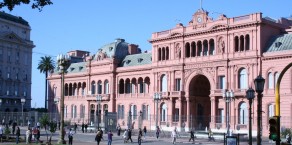














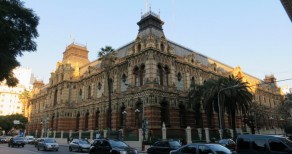
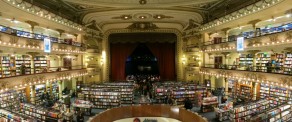





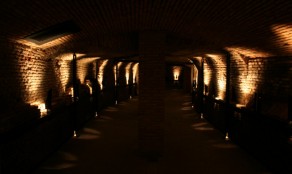
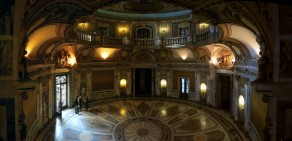







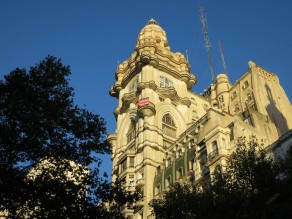
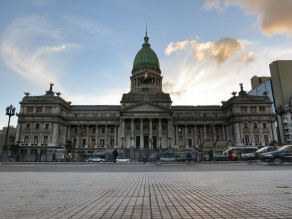
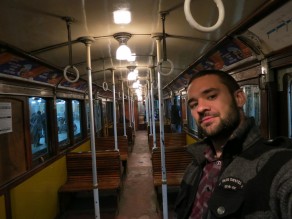




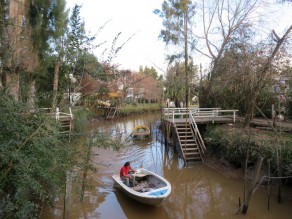
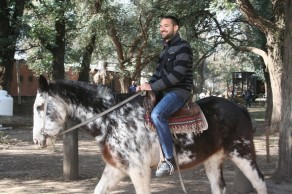


What kind of breed is the horse you are riding in the last photo? To put it mildly, it looks rather strange…
One of my favourite places in Buenos aires is a hidden garden on the corner of Reconquista and Peron streets. Enter through an old convent’s door from Reconquista street, and there it is. A quiet green space to lounge in the shade in hot summer days, right in the middle of the bustling Downtown (Microcentro). If you forgot your sandwich, there’s an on-site restaurant in the patio, where they serve traditional argentine fares at affordable price. Bueno provecho!
Damn, now I want to go to Buenos Aires just to eat “raw” steak and join in the protests….. Of course you know the statue of Luis Firpo in the cemetery showed him in his boxing robe….. Thank God he wasn’t wrapped up in a Snuggie 🙂
Hope you have a wonderful trip back home to Black Rock City….
Very nice guide! I arrived in San Telmo last week and La Poesía and Ateneo have both been my offices du jour. Definitely some new places to check out. What about milongas?
Side note: what’s the story with this snazzy responsive layout on your blog mixing in the sidebar maps and photos in to the text?
Oh you made my heart sing with you that someone noticed the responsive design. I’ve spent far too much time mucking about with that feature, but think I got it working now. 🙂
All CSS or some snazzy JS in there too? I’m going to start web inspector’ing. Sorry, can’t help myself. Been fiddling around with responsive layouts on my site as well so it’s on my mind. But yea, looks awesome.
CSS all the way, baby! The front page throws in some snazzy JS though. Inspect away!
You disappoint me, Gustav… you talk of eternally crying angels, and don’t even use the word “weeping”… no more cultural references? 🙂
Please accept my most sincere apologies for that cultural oversight. I’ve fixed it now. 🙂
–What? You missed the absolutely essential directive of indulging in dulce de leche each day? The world’s greatest flavor?
–OK, you made up for it in what Tyler noticed regarding your “snazzy” maps. You could win awards for best blog design 😉
–The first time I was in BsAs my path was blocked by some parade of public union workers. They were more raucous than a gaggle of tea partiers, I heard a bang, and quickly skedaddled. The next time I couldn’t get to the Casa Rosada because the square in front was filled with women screaming for lesbian rights or child labor laws, I can’t remember which.
–One side trip I recommend is Bariloche on the leeward side of the Andes to BsAs southwest, just one of those fancy South American bus rides away. It’s prosperous and next to the mountains and on a gorgeous lake. When there, eat a mouth watering grass fed steak at Alberto’s.
You are quite good at these travel tour blogs.
Love it Love it Love it!!! I look forward to someday seeing for myself and dancing my feet off!
xoxoxoRobin
Can’t believe it was nearly the end before you put a picture of yourself. Must be slipping!
I was in BA last year and you hit on a lot of the great spots I went to. The tour of the Palacio Barolo was so interesting and the guide was hilarious! We even had wine in his grandfather’s office! I also love the street shopping and breakfast in the cafes. I’m heading back in October for another year, so I’ll be sure to come back to your recommendations!
Amber
Believe me: if you go to Buenos Aires, the best thing to do is to walk through Alvear Avenue and its surroundings. Alvear Av is just 6 blocks long. It’s identical to Paris.
Marvelous blog! I have been to Buenos Aires several times and even so, reading your blog makes me plan my next trip – in 3 weeks time – very differently!
Let me know which other places you intend to visit!
Well… We “tried” to follow your plans. It was fun and great while it lasted, what your trip planning missed greatly was explaining the need to bring hard cash. My American dollar got me $14 peso ; however , only if I brought cash. My credit cards give me $9.25. That makes BA 50% more expensive . Maybe we shouldn’t have relied on just one location for our trip planning, but we did with you actually and by day 3 we were unable to do anything. Most places do not even accept a credit card. Oh well…
I’m sorry you had a poor experience. Regarding the Black Market US Dollar misunderstanding, I’m sorry you misunderstood my writing. I thought it was self-evident that to access to Black Market, you had to bring cash. But to make it really clear, I’ve changed “bring US dollars and trade them on the black market” to “bring US dollars (in cash) and trade them on the black market”.
But I am confused also how you managed to miscalculate how much money you would need. If you, before the trip, had checked the exchange rate, you would have received the official rate, not the black market rate, so your planning would have been unaffected.
Very nice article, so detailed. Me and my friends have been in Buenos Aires in last January. I´d like to add the Pope Francis Tour we took last month. We visited the “barrio” where Bergoglio lived as a child, where he played soccer on the corner playground, an amazing church where he was baptised and where he lived before being elected Pope and changed his name to Francis 1. The staff was so accommodating in planning our tour. For just a bit extra, the driver came to pick us up at a local residence. Our driver was amazingly helpful and kind. Our english-speaking guide was excellent, we could understand every word. The company is Kangoo Tours http://www.kangootours.wix.com/tours Hope I could help with my comment
Hejsan! Thanks for the tip!
I love reading your articles while planning my next trip (i find museums dull, too ha!).
We’re planning a trip to BA in November + 2 nights in Uruguay.
We can’t decide on whether 4 days is enough for BA or add 2 extra days.
What’s your recommendation?
Thanks!
Maria
Very good itinerary!
I was recently in Buenos Aires and and I loved it there, so much to see and do!
I also created my own 3 day itinerary for my blog, check it out and tell me what you think! 🙂
http://albertorw.com/blog/buenos-aires-3-day-itinerary
Holà from buenos aires!
We followed your itinerary, down to La Poesia.
Linea A was renovated but we rode the subte from Av. De Mayo to Plaza Miserere which we were told is the “old” part.
The meat at Gran Parilla was okay but, another real good spot was La Rambla in Recoleta (we had the steak sandwich, oio de bife and the fritas 😍).
Volta was yummy! We also tried Abuela Goye at Galeria Pacifico (you can find it in many places across the city).
Instead of the guided tour , we opted for tickets at the Teatro Colon (most expensive seats were at 350 pesos which is about 25$ which is as cheap as the guided tour!)
As for resto/pubs, check out 🍹
– Florelia Atlentico (try the Death Train with Chivas 12 and the cocktail off the menu with gin, basil, limon and sparkling wine + Pizza “our pizza” and the veal frittas)
– Dadà Bistro (we tried the milanese escalope, rib eye which goes perfectly with their oldest red wine San Feliciano Malbec). My boyfriend tried the Red Beer 🍻 👌🏻
– La Hormiga in Palermo has a warm atmosphere with good food. You can go there for a quick bite before a night out 🙂
Thanks again for the awesome itinerary and i hope the above helps 😃
Ciao!
Thanks for the wonderful comment! Always good to get reader-suggestions to these places. Glad you had a great time in this awesome city!
Hi, Gustav. Very nice site, I am an Argentinean, and I live in Buenos Aires. I must say, Florida street has importance in its history it is no doubt a landmark of Argentina. Check it out. https://en.wikipedia.org/wiki/Florida_Street It has earned the right for it to be in every guidebook, but now it’s just full of stores…(shame) If you take a look you can see the first Harrods store outside Britain, it is there, now abandoned. Check out the photos from those times you’ll see what I’m taking about.
Also a nice place to visit is Galleria Güemes, very well preserved, where you can have a view of the domes of the city, floor 14th it is a fairly short visit maybe 15/20 min but totally worth it.